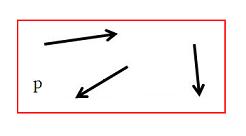COPLANAR VECTORS
The term vector can be used in different ways. In the field of physics , a vector is a quantity that is defined by its point of application, its direction, its sense and its quantity.

Coplanar , for its part, is a concept that is not part of the dictionary of the Royal Spanish Academy ( RAE ). On the other hand, the adjective coplanar does appear , which refers to the figures or lines that are in the same plane .
Beyond the fact that the notion is incorrect according to the grammatical rules of our language, the idea of coplanar refers to the points that are in the same plane (that is, they are coplanar points). When the point does not belong to said plane, it is considered not coplanar with respect to the others.
The coplanar vectors , therefore, are the vectors that are in the same plane . To determine this question, the operation known as the triple dot product or mixed product is used . When the result of the triple scalar product is equal to 0 , the vectors are coplanar (as are the points they join).
In this sense, starting from the meaning and the sense that coplanar vectors have, we can determine two notable statements that are worth taking into consideration:
-If there are only two vectors, they will always be coplanar.
-However, if you have more than two vectors, it may happen that one of them is not coplanar.
-Three vectors are coplanar or coplanar if their mixed product is equal to zero.
-Three vectors can be said to be coplanar or coplanar if they turn out to be linearly dependent.
These guidelines also allow us to affirm that, when the result of the aforementioned operation is different from 0, the vectors are non-coplanar. This means that these vectors, unlike coplanar vectors, are not part of the same plane.
For example: vectors A (1, 1, 2) , B (1, 1, 1) and C (2, 2, 1) are coplanar vectors since their triple scalar product is 0 .
In addition to this type of coplanar vectors, it must be taken into account that there are others that are also studied, such as these:
-Concurrent vectors, which are identified because their guidelines or lines of action intersect at a specific point.
-The parallel vectors, which are the vectors that are characterized because the lines that contain them are parallel.
-The sliding vectors, which have the particularity that, along what is their guideline, they can proceed to change position.
-The position vectors. They are also known as fixed vectors and they are identified because they have a fixed origin and because they come to record what a force is in space.
-The collinear vectors, which are identified because their lines of action are on the same line.
-Free vectors. They are those that have the ability to move towards parallel lines or along their directions without being forced to undergo modifications of any kind.
Comments
Post a Comment